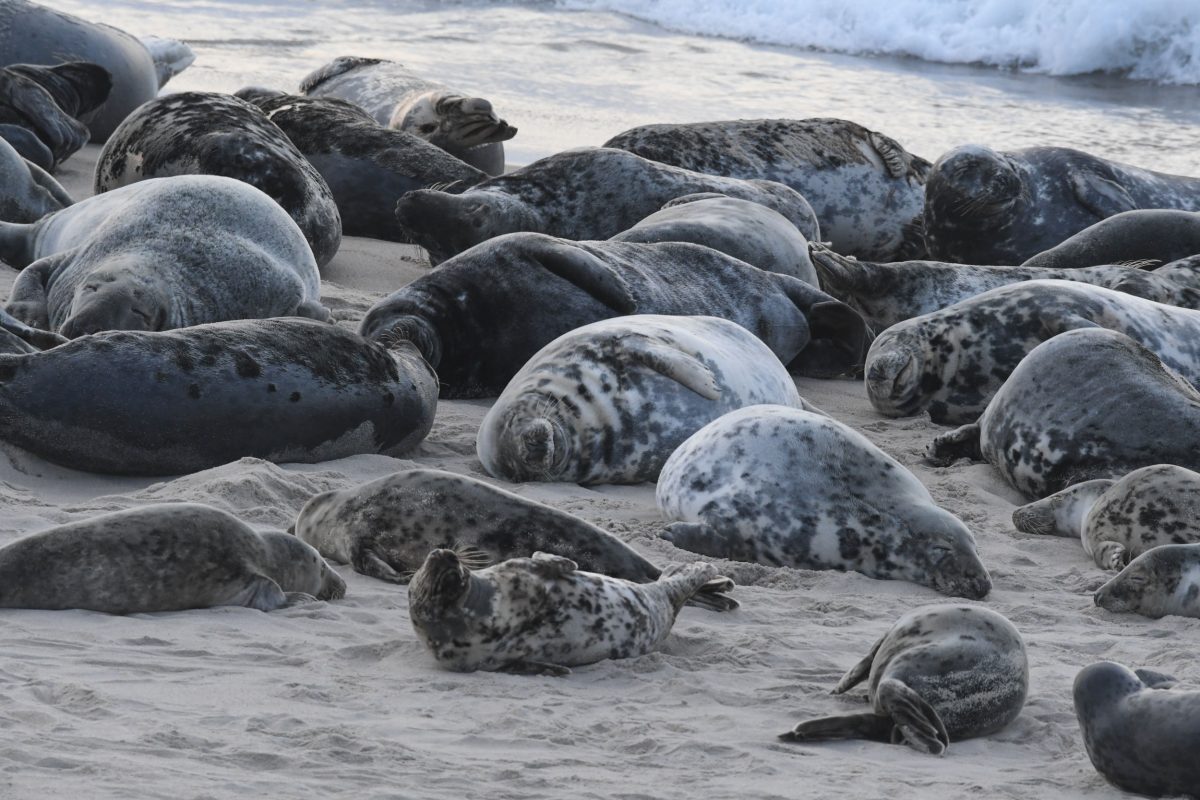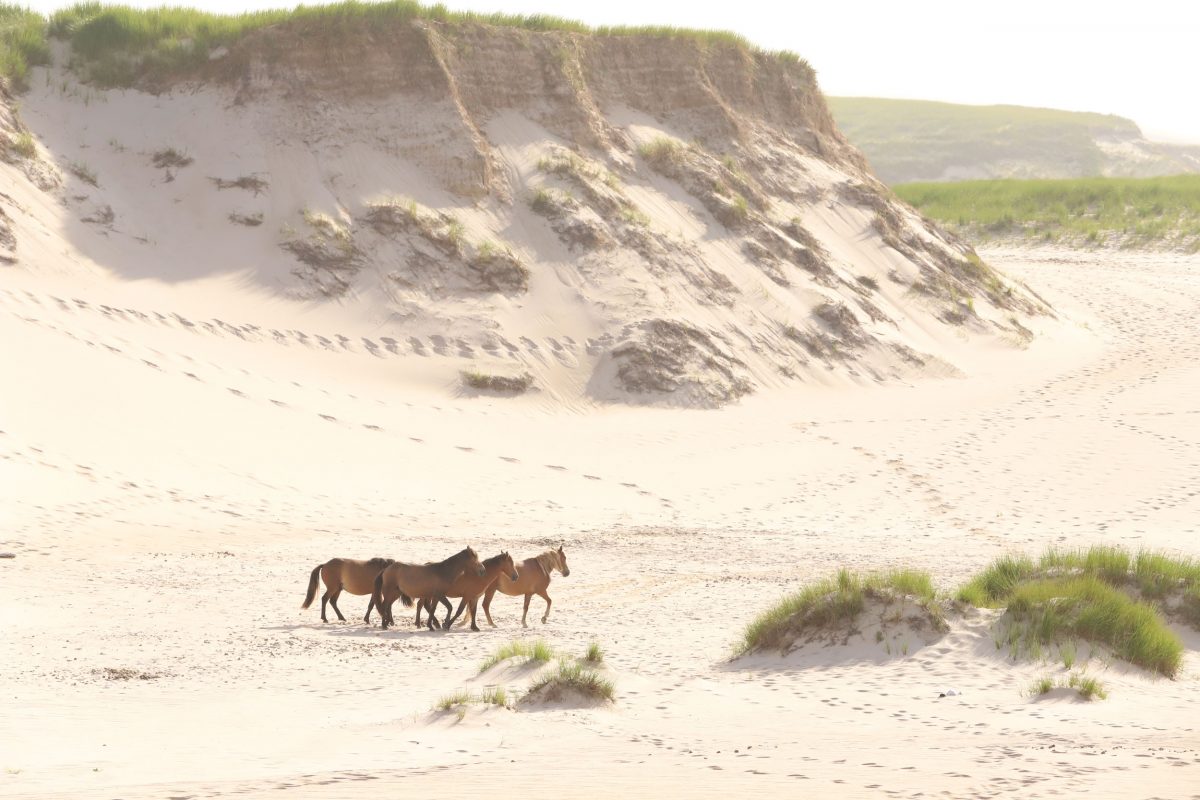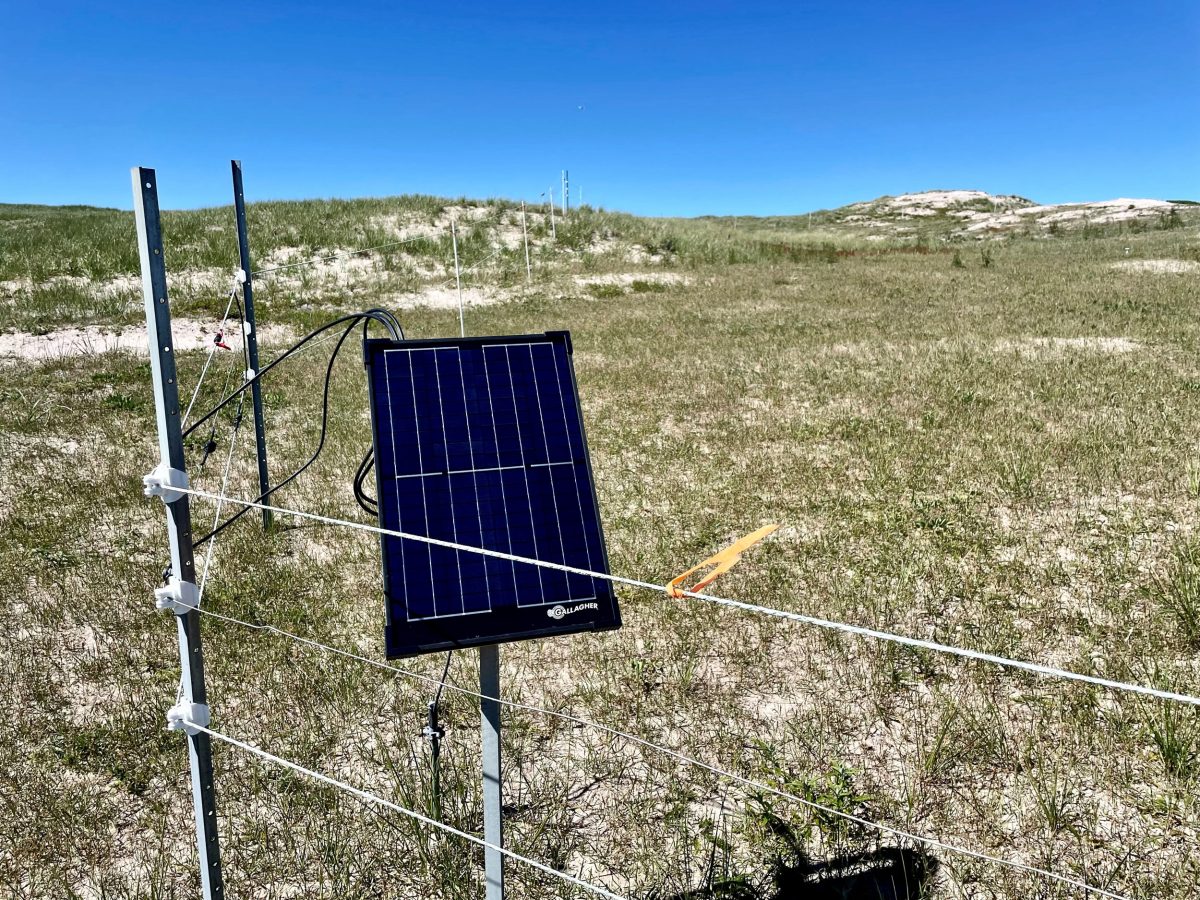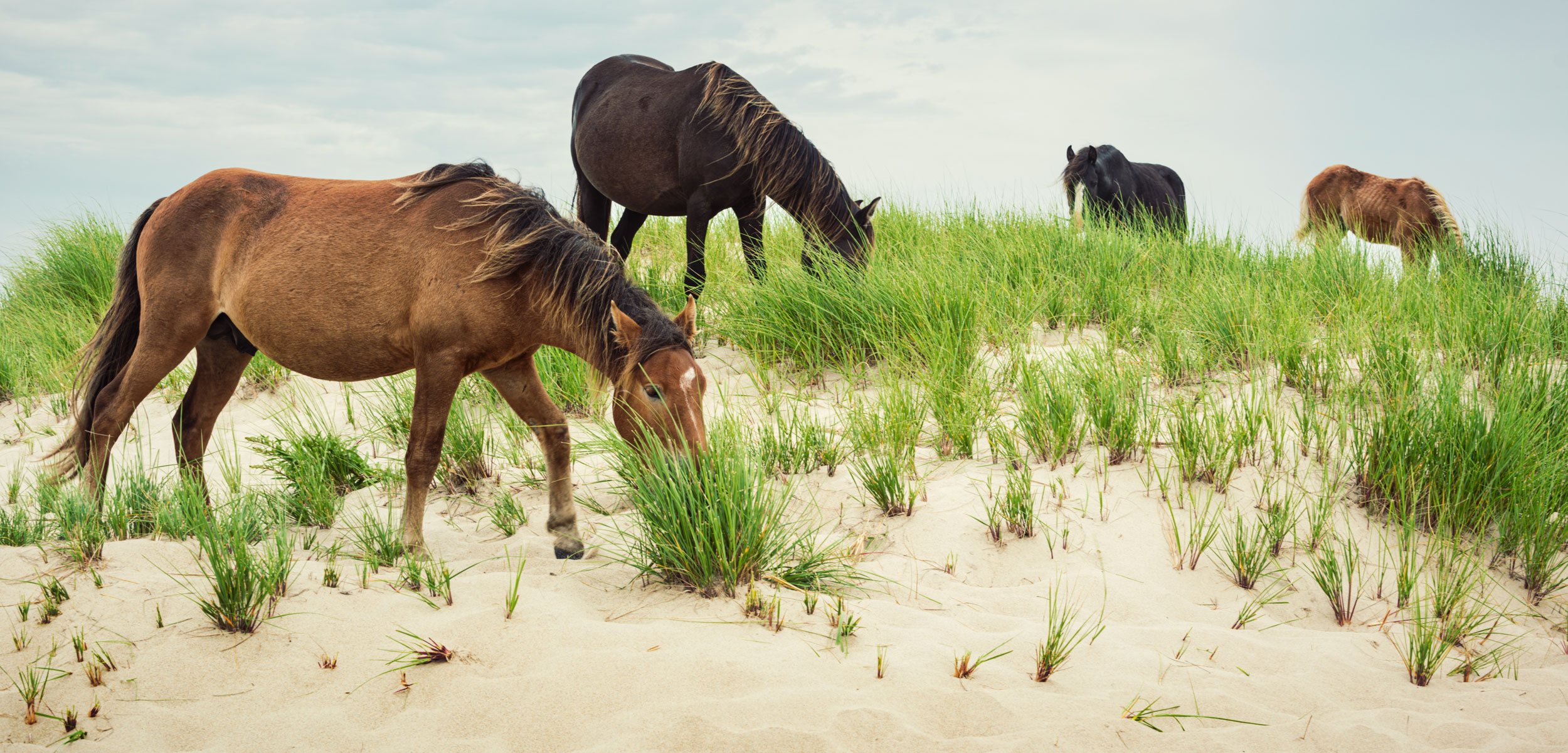Romance, Politics, and Ecological Damage: The Saga of Sable Island’s Wild Horses
They’ve roamed free for hundreds of years, but is that freedom harming the ecosystem they call home?
Article body copy
What is it that’s so compelling about the wild horses of Sable Island? Maybe it’s that they turn up where horses have no right to be—grazing on a sand dune, or standing on a broad beach beside the speckled form of a gray seal, or galloping through the window of a gallery in Manhattan, where I was once stopped short, in passing, by an image of the tangled mane and salt-flecked coat of a stocky Sable Island horse.
When I entered and told the person at the desk that I lived in Nova Scotia, the part of Canada closest to the largely uninhabited island, he was nonplussed. For most people, after all, the horses’ association with any human community is not the point. In the popular narrative of the horses of Sable Island, they exist independent of any human intervention and are well adapted to their particular environment: an ever-shifting sickle of sand in the Atlantic Ocean, 161 kilometers from the nearest landmass.
Sable Island—a 40-kilometer sandbar that exists at the intersection of ocean currents and is so narrow that standing on one side offers a vantage straight across to the ocean on the other—is a very particular environment indeed. Its long-recorded history, which dates back to a ninth-century Icelandic saga and its mapping by Portuguese sailors in the 1500s, is littered with accounts of deadly shipwrecks on the island’s treacherous shoals. Since the 20th century, nothing has done more to bolster Sable Island’s mythic status than its population of roughly 500 free-roaming horses, which have inhabited its dunes since they were abandoned there in the 1700s. Their images pop up everywhere from coffee table books to decorative scarves. There are at least two documentary films about the horses, and as many children’s books. Public interest in them hasn’t been restricted to the arts; in 2017, a group of Nova Scotian junior high school students attended an international science competition in Washington, DC, with a device that proposed using high-frequency sound and motion sensors to deter the horses from interfering with structures and, in turn, protect them from human influence. All of these—the books, the movies, the science experiments—rest on an understanding of the horses as a symbol of wildness, in tune with their ecosystem.

Sable Island is a 40-kilometer-long sandbar 161 kilometers off the coast of Nova Scotia. Map data by ArcGIS
Yet the extent to which that ecosystem is in tune with them is—like so much else about Sable Island—something of a mystery. To address that, scientists have embarked on a multiyear study of the horses’ relationship to the island’s ecosystems, a project officials with Parks Canada and the Sable Island Institute have titled Fences in the Sand. “There’s no question that horses are affecting the landscape. That’s visually apparent to anyone who comes to the island,” says Dan Kehler, park ecologist for Sable Island National Park Reserve, which covers the entirety of the island. “I think the question for us is, What are the consequences of some of those effects?”
The horses’ presence has provoked decades of debate—between those who want the horses protected as wildlife, and those who see them as an introduced species harmful to a sensitive ecosystem. This project and the horses themselves raise even broader questions about the ways public perceptions shape conservation, and how we decide which species belong where.
The horses may be Sable Island’s most famous residents, but they’re not its only inhabitants. Over the centuries, human settlements (including a luckless group of French convicts and a contingent of New England colonists) have come and gone on the island; now, along with a small population of seasonal researchers, a number of rare bird and invertebrate species live there, as does the largest breeding colony of gray seals on the planet, some 310,700 strong. (That’s up from approximately 2,300 in the 1960s.) Seal numbers are now so prodigious that some researchers theorize they’re changing the vegetation of the island, as their poop and carcasses provide additional nutrients for plants. Scientists think this could be increasing the number of horses, as better quality food becomes available, although a direct relationship hasn’t yet been established. What is certain is that the number of horses has risen dramatically in recent decades, from about 180 in the early 1960s, when they were first protected, to between 500 and 600 today. The increased presence of so many grazing animals has had an undeniable impact—more trails carved through the dunes, more vegetation worn down by horses’ chomping teeth—but what’s less clear is what role this plays in the broader changes underway on Sable Island.

The horses of Sable Island share their home with the world’s largest breeding colony of gray seals. Photo courtesy of Parks Canada
Kehler knows just how broad those changes can be. In 2016, his first winter working for the park, six kilometers of sand and vegetation disappeared from the island’s eastern tip after a spate of storms. “You’d go to the east end, and the island just stops. Where did the island go?” he recalls, with a laugh. It wasn’t the first time Sable Island had undergone major change: in the 18th century, a saltwater lagoon large enough to sail into existed in the center of the island. It has since disappeared—its boundaries were breached and the lagoon filled in with sand. In the 19th century, the main life-saving station—part of a group of staffed stations that once existed, with livestock and vegetable plots for staff and their families, to rescue anyone shipwrecked on the island’s shores—had to be moved several times, across 22.5 kilometers, because of erosion. Human attempts to stave off the island’s natural inclination to shapeshift have never had much impact; in the early 20th century, officials from the life-saving station planted a mix of conifers, deciduous plants, and fruit trees—some 83,000 seedlings as well as pine seeds—in an effort to address accelerating erosion on the island. None of the trees survived, though a hardy shrub abundant in some parts of the island might be a survivor of that doomed effort.
“It is very hard to study anything in isolation on Sable Island because it’s a place that’s at the mercy of oceanic forces, and every square centimeter of the island gets impacted by wind and waves in some way,” Kehler says. “So being able to tease out the horse signal is challenging.”
Still, a team of researchers is trying to do just that, hoping to understand how the horses shape the island’s landscape and ecology, and the influence they’re having on the island’s species of conservation concern, including its half-dozen endemic species, such as the threatened Sable Island sweat bee—only discovered in 2010—and the species that depend on the island for habitat, like the Ipswich sparrow, which breeds only on Sable Island.
Last summer, Krista Patriquin, project coordinator for Fences in the Sand, spent two months on the island, gathering baseline information. “We basically collected data on everything from the soil up,” she says. Then, this past fall, in unusually fine conditions—Sable Island is not known for its good weather—Patriquin and a team of volunteers spent two weeks of long days pounding fence posts and stringing electric fencing across the island’s rolling topography. These nine exclosures, ranging in size from a quarter hectare to nearly two hectares (for which electric fencing is the most humane option, Patriquin says), will establish areas that the horses can’t enter. Those plots will be studied over the next four years to assess changes to dune stability and soil content, pond vegetation and water quality, and habitat for at-risk species in areas where horses can’t tread.
An aerial view of Sable Island. Video courtesy of Parks Canada
While Kehler says recommending management approaches for the horses is not the focus of the study, the question of managing the herd of hundreds is long-standing. The project offers a glimpse into the complexities of controlling a population whose wildness exercises a commanding hold over the public imagination.
An eyelash of sand in the North Atlantic is an unlikely spot to find livestock, but since the 1500s, Sable Island has periodically played host to a reserve supply of sheep, cattle, and pigs for sailors cruising the coast, as well as dogs, cats, and rabbits for the island’s short-lived settlements. As the horses’ origin story goes, they’re likely the descendants of animals left on the island in the 1700s by a Boston merchant named Thomas Hancock, who used the island to stash horses he’d either bought or stolen after the British expelled the Acadians from Nova Scotia and forced them to leave their livestock behind. In subsequent centuries, the superintendents of the island’s life-saving service, which operated from 1801 to 1958, occasionally introduced new horses to “improve” the population—which is to say, make them more marketable—but the horse transfer often went in the other direction, as portions of the population were rounded up for slaughter or sold on the mainland as work animals. Then, in 1960, the horses experienced an abrupt reversal of fortune. Prompted in part by fears that the horses were damaging the island, as well as concerns for their welfare, the federal government planned to remove all the horses. The plan came to public attention, which unleashed a torrent of opposition—including a deluge of letters from Canadian schoolchildren. The backlash was so severe it not only stymied the plan but resulted in then–prime minister John Diefenbaker protecting the horses under the Canada Shipping Act in 1961.
Since then, the horses have existed as an entirely unmanaged population, but the debate between ecologists, government officials, and animal lovers over what to do with the herd—whether to remove the horses, manage their numbers, or leave them alone entirely—has never fully gone away. In 1998, a report by the Canadian Wildlife Service noted a lack of research about the horses’ effects on the island’s stability and recommended further study, as well as possible management of the population. But it also noted that “the feral horses have come to personify Sable Island, so decisions which affect their well-being will be subject to close public scrutiny.” That scrutiny has manifested in the public closely tracking the state of the herd, with particularly bad years receiving widespread media attention—such as 1980, when newspapers across the country reported that the population had dropped to 150, from 359, after a harsh winter.

It is unclear how many horses were first landed at Sable Island in the 1700s, but today’s population is somewhere between 500 and 600. Photo courtesy of Parks Canada
The debate became even more salient when the island joined Canada’s network of national parks in 2013. Areas for new national parks are chosen based on how well they “portray the geology, physiography, vegetation, wildlife, and ecosystem diversity characteristic of the natural region,” according to Parks Canada. In the case of Sable Island—though it is unique, as the most remote island in the region—one four-legged factor played a particularly important role, and in public consultations leading up to the designation, support for the park was closely tied to the promise of continued protection of the horses.
“It’s an interesting case because you really have two defining principles of thinking that are in conflict with one another at this island,” says Ian Jones, a marine bird biologist at Memorial University in Newfoundland and Labrador. On the one hand, there’s Parks Canada’s commitment to protecting the horse population. On the other, he says, are Parks Canada’s own policies, which mandate preserving ecological integrity, and the concept of remote-island conservation, where the ecology of remote islands is defined by the absence of introduced species, including terrestrial mammals and plants.
Jones says a relevant comparison to Sable Island is Guadalupe Island, off the western coast of Mexico. In 2007, officials finished removing a population of feral goats that had become the dominant ecological force on the island; since then, native plants, including some thought to be extinct, have returned. Another example, he says, is the ongoing removal of deer, raccoons, and other nonnative species from Haida Gwaii, an archipelago of islands off the coast of British Columbia. From Jones’s perspective, the same thinking could be applied to Sable’s horses.
“They are invasive, they are introduced,” he says. “Just like all kinds of other things that are being controlled in various national parks.”
But the question of whether the horses are truly invasive—meaning, an introduced species that causes harm in its new range—is also complex.

The charisma of Sable Island’s very photogenic wild horses has furthered their existence on the island. When the Canadian government decided to remove the horses in the 1960s over concerns of animal welfare and the ecological damage the horses might be doing, public outcry reversed the decision. Photo courtesy of Parks Canada
A 2014 report titled “An Ecological and Biodiversity Assessment of Sable Island,” prepared for Parks Canada by biologists from Dalhousie University and other institutions and obtained through an Access to Information Act (ATIA) request, notes that while the view of some ecologists that the horses are invasive is supported by compelling evidence, public opinion leans in a different direction. “The majority of Canadians feel that the horses have become an integral component of the Sable Island ecosystem and that they are worthy of protection,” the authors wrote. Parks Canada’s official position is that the horses are a naturalized species—a nonnative species that has existed in an ecosystem for some time—so they protect the horses as wildlife.
Ultimately, the assessment concludes that arguments for and against the horses’ removal are shaped in part by emotions—emotions that other documents obtained through the ATIA suggest parks officials are well aware of. One slide in a presentation about the Fences in the Sand study called it “a highly sensitive project.” A separate 2015 report by Parks Canada staff on the ecological integrity monitoring for the island referenced a recommendation that the viable minimum horse population be set at 200, but also said that establishing a carrying capacity, or sustainable upper limit, would be much more fraught. “Controlling an overabundant horse population would be politically challenging, so setting upper thresholds would require detailed information on the grazing ecology of horse[s] based on exclosure experiments,” the report says. A briefing note about the Fences in the Sand study—which is now running those exclosure experiments—put “public sensitivity around the wild horse population” as one of the higher risk factors for the project.

Parks Canada’s Fences in the Sand study is using exclosures to observe what happens to the natural ecosystem when horses are excluded. Photo courtesy of Parks Canada
One area of focus is the island’s freshwater ponds, which in some places were starting to look like they had “well-used pasture” along their shores, according to another report, prepared for Parks Canada by the Atlantic Canada Conservation Data Centre, an agency that conducted surveys of the island’s freshwater pond plants in 2015. Changes are also taking place within the ponds themselves. Since 2019, Andrew Medeiros, a freshwater ecologist at Dalhousie University, has been sampling the island’s ponds by conducting biodiversity assessments and taking sediment cores that could reveal how pond life has changed over centuries. The results, parts of which have not yet been published, suggest that there are differences in pond biodiversity over time, as the vegetation around the ponds changes. Still, it’s hard to say how much of this is from horses, and how much is due to factors like storms shifting the island’s sands.
The impact of horses might be more apparent in the increased abundance of invertebrates in some ponds, potentially because the horses’ droppings can boost the growth of algae, which, in turn, many invertebrates eat. The presence of horses may also be shaping invertebrate life in the ponds in another way: it’s unusual for a high number of invertebrate parasites to be in lakes without an animal host to transfer them there, says Medeiros. “I’ve never seen so many parasites before in my entire career.” Medeiros cautions it’s too soon to say for certain whether horses are the source of these changes; birds or seals could also be responsible. Parks Canada’s Fences in the Sand study could help answer these questions. Regardless, other research has shown the Sable Island horses are carrying a parasite load far higher than that of domestic horses; one study suggested this may contribute to death by starvation in leaner times. (Research indicates the horses have an average life expectancy of about six years for males and 4.5 for females; by contrast, wild horses on a barrier island in North Carolina’s Cape Lookout National Seashore live, on average, for 11 years, and a domestic horse can live between 25 and 30.)
Medeiros stresses he’s an aquatic ecologist, not a horse biologist, and doesn’t have a scientific stance on the horses, but given the pressures on the population, he wonders why the horses are left to run wild. “We manage deer at Point Pelee [National Park], we manage moose in Gros Morne [National Park]. Why don’t they manage horses on Sable Island? I think maybe it’s because of people’s perception. They want it to be not managed.”
Proponents of leaving the horses unmanaged often point out that the island’s ecology has changed alongside the horses and, in a way, this applies to ponds, too; across Sable Island, freshwater ponds blink in and out of existence, sometimes over the course of a single year. Of the ponds Medeiros has studied, only one pre-dates the 20th century. That older pond dates back to the 1700s, but since the horses arrived then, too, establishing a pre-horse baseline against which the island’s freshwater ecosystems could be measured, let alone restored, is tricky—especially as the island itself is constantly changing. “How could you restore an ecosystem that didn’t exist prior to the impact?” Medeiros says.

If horses didn’t live on Sable Island, would people care much about this small spit of shifting sand? Photo courtesy of Parks Canada
All of this raises a broader question: if the Sable Island horses are a naturalized species, which version of Sable Island do they naturally inhabit? The one prior to European arrival, the Sable Island of the present day, or the island of the future, which climate change is likely to reshape in far more dramatic ways than the horses have? Perhaps the iteration they’re most central to—which, for an environment as mutable as Sable Island may also be the most enduring version—is the island that exists in the public imagination.
And that points to the role the horses play as gatekeepers: if it weren’t for them, people likely wouldn’t care as much about a sandbar in the North Atlantic—and species like the diminutive Sable Island sweat bee, whose image adorns neither coffee table books nor decorative scarves, and that wouldn’t capture enough public attention to justify the federal government spending hundreds of thousands of dollars on research. That research, while sparked by the horses, will ultimately provide information about the island’s lesser-known species and the planetary forces reshaping the landscape. In that way, however, the horses have changed their ecosystem, they’ve also prompted people to take a closer look at a remote spit of sand in the North Atlantic, and for the island, that may yet prove critical to its future.
For the past several years, Geordie Mott has been running photography tours on the island, though his connection to the place goes back much further than that. His great-great-grandfather was a notable (and notably drunk, according to family lore) sea captain who, as Mott heard from his grandfather and uncle, the government made superintendent of Sable Island to keep him out of trouble. This superintendent’s daughter, who’d also gone to the island, met Mott’s great-grandfather there in the early 20th century, and they moved to the mainland together.
Mott says that most of the people on his trips come to watch the horses roam the island. But once people have flown to Sable—watching the ribbon of sand appear on the horizon, before landing on the beach—Mott tells them other stories: about the battering the island is already taking from climate change, and the prevalence of plastic on the island’s shores, and the long history of human interaction with what some visitors assume is an untouched stretch of wilderness. It’s a reminder of the far-reaching influence of humans on the planet’s fragile and unique places—a story to which the horses of Sable Island, wild or not, are inextricably linked.

